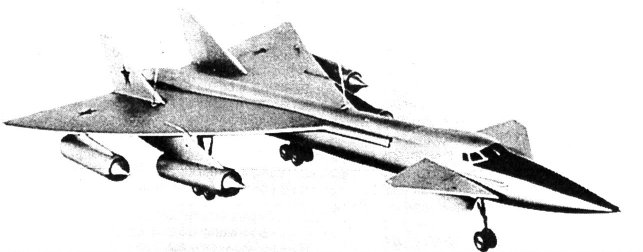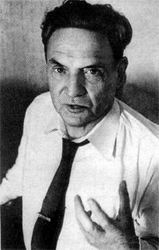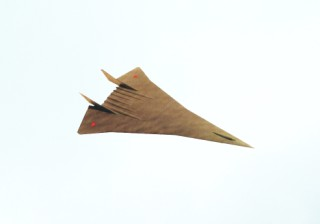The M-57 project originated as part of the Soviet Union's quest for a next-generation strategic bomber in the late 1950s. This was a time when both the United States and the USSR were pushing the boundaries of aerospace technology, seeking aircraft that could outrun and outmaneuver air defenses. In addition to traditional strategic aviation systems, the Air Force considered it expedient to develop a low-altitude (250-600 m) intercontinental bomber system with a jump in the target area to 16,000-17,000 m with a nuclear power plant and armed with guided missiles with a flight range of 500-1000 km. Within the framework of these proposals, in July 1959 ,
The Beginning – Cold War Aviation Trends (1950s)
By the mid-1950s, strategic bombers were the backbone of nuclear deterrence. The Soviet Union relied on high-altitude, long-range bombers like the Tu-95 and M-4 for nuclear strike missions. However, advancements in Western jet interceptors (like the F-104 Starfighter, English Electric Lightning) and surface-to-air missiles (like the Nike and Bomarc systems) made high-altitude bombing increasingly dangerous.
To counter this, Soviet engineers explored alternative strategic bomber concepts, including:
The Myasishchev OKB, under Vladimir Myasishchev, was a leading Soviet design bureau specializing in high-performance bombers. In the mid-1950s, they developed the M-50 and M-52, both supersonic bombers with Mach 2+ speeds, but these were ultimately canceled.
MYASISHCHEV, Vladimir Mikhailovich (28.09.1902 - 14.10.1978)

M-57 – Evolution of the Concept (1959)

![186370-8d335dc1eb7fed8f230b8b46da147754~2[1].jpg 186370-8d335dc1eb7fed8f230b8b46da147754~2[1].jpg](data:image/svg+xml;charset=utf-8,%3Csvg xmlns%3D'http%3A%2F%2Fwww.w3.org%2F2000%2Fsvg' width='500' height='985' viewBox%3D'0 0 500 985'%2F%3E)
Robert Ludvigovich Bartini
A-57 Bomber
Result: The required technology (engines, heat-resistant materials, aerodynamics, and fuel efficiency) was simply not available in 1959.
 ICBMs replaced the need for high-speed bombers.
ICBMs replaced the need for high-speed bombers.
 Technology (materials, engines, aerodynamics) was not ready for sustained Mach 3+ flight.
Technology (materials, engines, aerodynamics) was not ready for sustained Mach 3+ flight.
 Cost was too high, with resources redirected to missiles and space programs.
Cost was too high, with resources redirected to missiles and space programs.
 Myasishchev OKB was shut down in 1960, halting development.
Myasishchev OKB was shut down in 1960, halting development.
 Improving U.S. air defenses made bombers less survivable.
Improving U.S. air defenses made bombers less survivable.
 Similar U.S. Mach 3+ bomber projects (XB-70) were also canceled.
Similar U.S. Mach 3+ bomber projects (XB-70) were also canceled.
Despite its cancellation, the M-57 influenced later Soviet designs, such as:
OKB V.M. Myasishchev
under the leadership of L. L. Selyakov prepared a preliminary project of the strategic aviation system M-57, which was a further development of the ideas laid down in the M-56 project . Preliminary estimates indicated that it was possible to obtain an aircraft with a wing area of 400 m2 and a mass return on fuel of 70.2%.The Beginning – Cold War Aviation Trends (1950s)

By the mid-1950s, strategic bombers were the backbone of nuclear deterrence. The Soviet Union relied on high-altitude, long-range bombers like the Tu-95 and M-4 for nuclear strike missions. However, advancements in Western jet interceptors (like the F-104 Starfighter, English Electric Lightning) and surface-to-air missiles (like the Nike and Bomarc systems) made high-altitude bombing increasingly dangerous.To counter this, Soviet engineers explored alternative strategic bomber concepts, including:
- Extreme high-speed bombers (Mach 3+ to outrun interceptors and missiles).
- Low-altitude penetration bombers (to avoid radar detection).
- Nuclear-powered bombers (to achieve unlimited rang)
L . L Selyakov
Myasishchev’s Role – The Birth of the M-56 & M-57
The Myasishchev OKB, under Vladimir Myasishchev, was a leading Soviet design bureau specializing in high-performance bombers. In the mid-1950s, they developed the M-50 and M-52, both supersonic bombers with Mach 2+ speeds, but these were ultimately canceled.

MYASISHCHEV, Vladimir Mikhailovich (28.09.1902 - 14.10.1978) M-56 – The Predecessor (Mid-1950s)

- The M-56 was Myasishchev's first major "Mach 3 bomber" concept.
- It was intended to cruise at 3,000 km/h (Mach 3) at high altitude and was shaped like a flying wing.
- It never progressed beyond the design phase due to material and propulsion limitations.
M-57 – Evolution of the Concept (1959)

(The M-57 of 1960 is the last Myasishchev project before the design bureau dissolved. It is a large all-wing, twin-tailfin aircraft. The only evidence of its existence is this 5ft (1.5m) long model which survived in one of the design bureau rooms.)
As an evolution of the M-56, the M-57 project began in July 1959 under OKB-23, led by Leonid Selyakov. It was designed as an advanced low-altitude intercontinental bomber with a high-speed dash capability. The project also drew inspiration from Robert Bartini’s A-57, a radical flying-wing bomber proposal.

![186370-8d335dc1eb7fed8f230b8b46da147754~2[1].jpg 186370-8d335dc1eb7fed8f230b8b46da147754~2[1].jpg](https://www.secretprojects.co.uk/data/attachments/300/300393-904055373d148319c767b6c80cb2c974.jpg)
Robert Ludvigovich Bartini
A-57 Bomber
Externally, the M-57 was similar to the A-57 bomber project of R. L. Bartini . According to the project, the M-57 aircraft was to be made using the "flying wing" scheme (there was an option with a horizontal canard). The calculated area of the delta wing with a sweep angle along the leading edge of 75° in the final version was determined to be 400 meter square , the calculated cruising aerodynamic quality in supersonic mode was within 5.9-6.2. The takeoff weight reached 250 tons, while the mass return on fuel reached 72.0%. The power plant was to consist of six NK-11 (NK-15) engines. The cruising supersonic flight speed of the M-57 was to correspond to Mach 3.6, and the ceiling above the target to reach 26,000 m. The aircraft's armament was to consist of 2 Kh-22 missiles.
It was planned to begin flight tests of the aircraft in 1963. As with the M-56, all work on the project was stopped in the early 1960s.Description
| Design | OKB V.M. Myasishchev | |
| Designation | M-57 | |
| Year of construction | project 1959 | |
Stage I | Stage II | |
| Type | Strategic bomber | |
| Crew, persons | 3 |
Geometric and mass characteristics
| Wing area, m2 | 400 |
| Cruising aerodynamic quality (at supersonic speed) | 5.9-6.2 |
| Maximum takeoff weight, kg | 220000-240000 |
| Weight of fuel and oil, kg | 137000 |
| Mass return on fuel, % | 72 |
Flight data (estimated)
| Cruising flight speed, km/h (M=) | up to 3000 | up to 3200 (3.6) |
| Speed of the flying projectile, km/h | 3700 | |
| Ceiling, m | over the target | 26000 |
| practical | 24000 | 25000 |
| Flight range, km | 16200 | 17200 |
Armamant
2 × Kh-22 (AS-4 'Kitchen') Cruise Missiles



Why the M-57 Was Never Built ?
1. Shift in Soviet Military Strategy – The Rise of ICBMs
By the late 1950s and early 1960s, the doctrine of nuclear warfare was rapidly evolving.- The Soviet Union had successfully tested its first intercontinental ballistic missile (ICBM), the R-7, in 1957.
- ICBMs provided faster, more direct nuclear strike capability compared to bombers.
- Unlike bombers, which required hours to reach their target, ICBMs could strike in minutes, making them more effective in a first-strike or retaliatory scenario.
- By 1960, Soviet leadership, including Khrushchev, strongly favored missiles over manned bombers.
2. Extreme Technological Challenges
Designing a Mach 3.6 intercontinental bomber in the late 1950s presented major engineering obstacles.A. Engine and Propulsion Limitations
- The NK-11 (or VK-15) turbojet engines needed to sustain Mach 3.6 speeds for long durations.
- No Soviet engine at the time could handle the extreme temperatures and stresses associated with such speeds.
- Heat-resistant titanium alloys and advanced cooling systems were required, but the USSR was still developing these materials.
- Even the U.S. XB-70 Valkyrie, with advanced General Electric turbojets, struggled with sustained Mach 3 flight.
B. Aerodynamic and Structural Issues
- The delta-wing configuration with a 75° sweep was optimal for high-speed flight but made low-speed takeoff and landing difficult.
- At Mach 3+, aerodynamic heating would cause severe structural stress.
- Thermal expansion and contraction needed special materials, but the Soviet Union was still developing titanium-based aircraft structures (used later in the MiG-25).
Result: The required technology (engines, heat-resistant materials, aerodynamics, and fuel efficiency) was simply not available in 1959.
3. Cost & Resource Constraints
- The M-57 was an extremely expensive project, requiring major investment in new materials, new engines, and specialized manufacturing.
- The Soviet Union had limited funding for experimental bombers due to Cold War tensions, economic constraints, and competing projects.
- Alternative projects, like ICBMs and space programs, received higher priority.
4. Myasishchev OKB Shutdown (1960)
- The Myasishchev Design Bureau (OKB-23) was the primary developer of the M-57.
- In 1960, Soviet leadership ordered the closure of Myasishchev OKB, redistributing resources to other aviation projects and space exploration.
- Many of Myasishchev’s engineers were reassigned to work on ICBMs and space launch vehicles at OKB-52 under Vladimir Chelomey.
- Without Myasishchev OKB, the M-57 had no team left to develop it.
5. Vulnerability to Enemy Air Defenses
Although the M-57 was designed for low-altitude penetration (250-600m) and high-altitude dashes (26,000m), new Western defense systems threatened its survivability.A. Surface-to-Air Missile (SAM) Threats
- By the late 1950s, U.S. SAM technology was advancing rapidly.
- The Nike Hercules missile could intercept bombers at high altitudes.
- The Boeing BOMARC missile system was specifically designed to counter high-speed, high-altitude bombers like the M-57.
B. The Shift to Airborne Early Warning & Interceptors
- Airborne radar systems like the U.S. EC-121 Warning Star could detect incoming bombers long before they reached their targets.
- The F-106 Delta Dart and British Lightning interceptors could engage high-speed targets.
- Even at Mach 3+, the M-57 might not evade interception before launching its Kh-22 missiles.
6. Similar U.S. Projects Also Canceled
- The U.S. XB-70 Valkyrie, a Mach 3+ strategic bomber, faced similar technological and strategic challenges.
- The North American XF-108 Rapier, a high-speed interceptor meant to counter Mach 3 bombers, was also canceled.
- The fact that even U.S. aviation leaders abandoned Mach 3 bombers showed that such designs were impractical at the time.
Conclusion – Why the M-57 Was Never Built
The M-57 was an extremely ambitious aircraft that was ultimately too advanced for its time. Several major factors led to its cancellation:Despite its cancellation, the M-57 influenced later Soviet designs, such as:
- The Sukhoi T-4 (Mach 3 experimental bomber, 1970s).
- The MiG-25 (Mach 3 interceptor, 1969).
- The Tu-160 (modern supersonic strategic bomber, 1980s).







